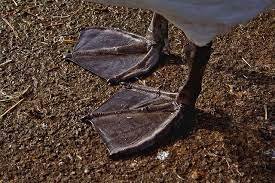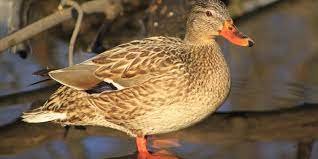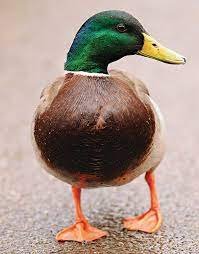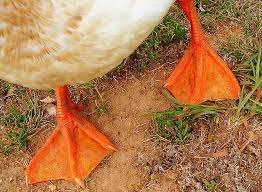Birds that can swim on or under the water’s surface benefit greatly from having webbed feet. The amount of webbing between a water bird’s toes is the most noticeable difference between species.
Ducks, which are also known as waterfowl, have webbed feet. The most prevalent kind of webbed foot looks like this. When the three forward-facing toes are webbed together but the hallux (the little, elevated toe at the back of the foot) is not, the toes are said to be palmate. Numerous waterfowl, such as ducks, gulls, terns, swans, and geese, have triangular feet. The Latin term “palmatus,” which means “formed like an open palm,” is the etymological ancestor of the English word “palmate.”
There are, however, four distinct kinds of webbed bird feet.
Also, know What is the State Bird of Missouri?
Palmate feet

Among birds that have webbed feet, palmate feet are the most prevalent. Flamingoes and other aquatic birds share this trait with other waterfowl including ducks, geese, gulls, swans, and the like.
There are three webbed toes in the front of a palmate foot. The small toe in the rear of the foot, however, is not connected to the other toes and is pointing backward.
Totipalmate Feet

Only birds with four webbed toes, called totipalmate, have this type of webbing. To propel itself through the water, the bird can use all four of its toes, which are webbed together. Having this knowledge will greatly improve one’s swimming efficiency. This form of webbing is unique to gannets, pelicans, and frigatebirds and is not observed in ducks or swans.
Semipalmate feet

Semipalmate feet resemble palmate feet in that a web connects the toes on the front of the foot. Webbing is present, but it is much narrower than in the palmate variety, so the front toes are not joined together all the way along their length.
Sandpipers, plovers, avocets, herons, and even some species of domestic hens have semipalmate foot.
Lobate Feet

There are noticeable skin lobes on the toes of people with lobate feet. Even though it doesn’t join the toes, this increases your effective surface area, which helps you swim faster. In order to accommodate the birds’ expanding and contracting skin as they swim, this material is stretchy. The lobate foot not only increases the animal’s surface area in the water but also makes it easier for it to propel itself through the water. Semi-lobate feet, such as those found on otters, have a smaller skin flap but still provide some webbing, making these animals excellent swimmers.
How do ducks use their feet?

The feet of ducks are specialized in several ways that contribute to the birds’ ability to swim, fly, walk, and keep a constant internal temperature. Their webbed feet are ideal paddles, and they spend a lot of time in the water, so they can swim quickly and efficiently. The swimmer’s toes are extended wide apart to provide more powerful propulsion through the water. Similar to how a rowing crew “feathers” their oars at the end of each stroke, swimmers close and bring forward their toes to prepare for the following stroke. When the bird has to change course, it uses its feet as a rudder.
How many legs do ducks have?

There are four limbs on a duck. You’ve got four limbs total:
Ducks are a species of aquatic, terrestrial, and avian birds. Their thighs and legs are both robust. Many types of ducks found in water have their legs set quite far back on the body. However, a duck’s wings are brief and asymmetrical. Ducks need powerful muscles for the rapid wing flapping required during flight.
Each feeding environment requires a unique arrangement of the duck’s feet and legs.
In order to maximize their efficiency while swimming underwater, diving ducks position their legs and feet far back along their bodies. Walking stability is improved in ducks that spend more time on land because their legs and feet are positioned more centrally. For aquatic propulsion, ducks rely on their webbed feet.
As taking flight from the ground is difficult, ducks utilize their webbed feet to gain the necessary speed.
The shortened wings of diving ducks improve their underwater propulsion. As a result, they have to race through the water using their webbed feet to gain enough momentum to take flight. The feet of ducks are designed to absorb impact. Ducks are able to land softly on water because their feet act like water skis. When a duck lands, it slows down before the rest of its body hits the water since its feet have already touched the surface.
Why are ducks’ feet orange?

The duck is getting all the vitamins it needs, as evidenced by its orange feet. Bill and foot color change, however, serve a purpose in the mating process.
People of the opposite sex are drawn to orange. Therefore, during the months of December and January, when mallards are courting and mating, both sexes have an orange foot and beak.
The webbed feet of a duck serves a dual purpose: both in the water and in maintaining a comfortable internal climate. Spreading the webbing in between their toes, ducks gain additional contact area. The Ducks are better able to dissipate heat as a result of this. Ducks will stand in water or mud to cool themselves when the weather is hot.
In order to expand the area of their feet and hence the cooling effect, they spread their toes. Ducks can keep warm in the winter thanks to the air that is trapped between their toes thanks to their webbed feet. The air pockets serve as insulation, preventing the ducks’ feet from getting cold. They may also prevent blood from flowing to their legs, allowing them to stand on cold floors for long periods of time.
Conclusion

In order to survive, every animal on Earth has developed its unique characteristics. The fittest animals would breed, and their genes would be passed along to future generations. More matings occurred between ducks with webbed feet because of their reproductive success as hunters and swimmers. When swimming, ducks can use their webbed feet as paddles. Their ability to propel themselves through the water is enhanced by the webbing between their toes. Waterfowl have webbed feet called palmate feet, and no other animals have them. The primary function of the palmate feet is to aid birds in the aquatic environment. Ducks, geese, gulls, and swans can swim well thanks to their webbed, palmate feet.





